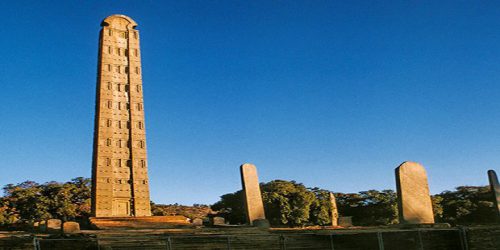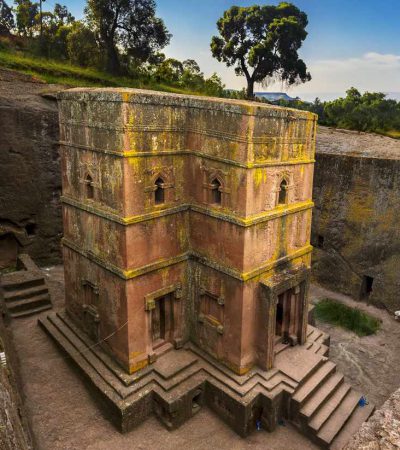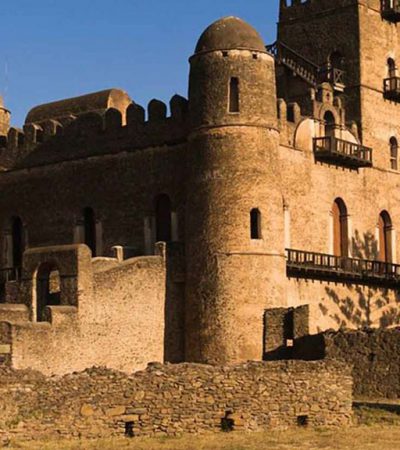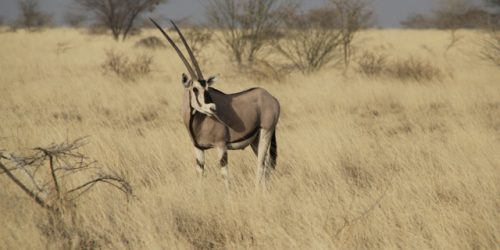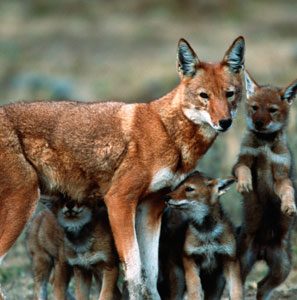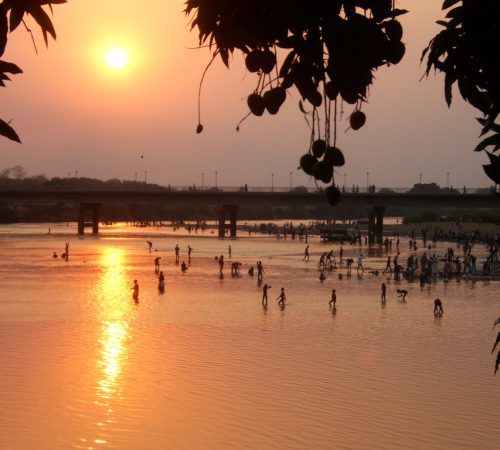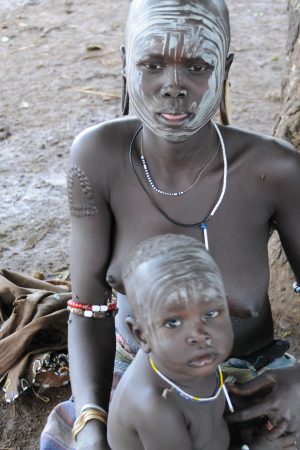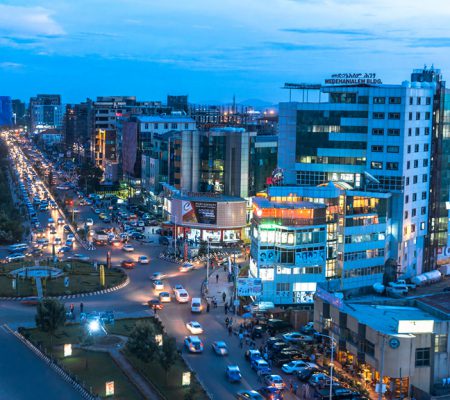Attractions

 Discover
Discover
Axum
Much more is known about the historic highland city of Axum, once a great commercial centere, trading via the Red Sea port of Adulis and founded perhaps 500 years after the decline of Yeha. Axum stands in the highlands of north western Tigray, commanding spectacular views over the nearby Adwa hills. This ancient settlement is frequently referred to as ‘’the sacred city of Ethiopians’’- a description that adequately sums up its significance in national culture as a center of Orthodox Christianity.
Many remarkable monuments here attest to the great antiquity of religious expression in this country, and as a former capital that has never lost its special appeal to the hearts and minds of all Ethiopians.
Axum is renowned for its Cathedral of St.Mary of Zion where, legend has it; the original Ark of the Covenant is housed. Axum is also famous for its seven mysterious monolithic stelae, hewn from single pieces of solid granite. The most notable are carved to multi-storey houses; several weigh more than 500 tones and stand 20 meters high. Axum’s greatest significance, however, is as the epicenter of the Queen of Sheba’s dynasty, upon which rests the notion of the sacred kinship of the Semitic peoples Ethiopia- a notion that links the recent past to ancient times.
 Discover
Discover
Lalibela
Lalibela is an ancient settlement, which is also famous for its rock hewed churches. Lalibela is a city carved from legend-a medieval settlement in the Lasta area of Wollo that is the site of II remarkable rock-hewn monolithic churches, believed to have been built by King Lalibela in the late12th century. These notable structures are carved inside and outside the solid rock, and are considered among the wonders of the world. Each building is architecturally unique, and several of them are decorated with fascinating rock paintings.
The unadulterated biblical atmosphere and vivid local colour of the Timket celebration provide an ideal opportunity to see Lalibela as a sacred centre whose roots go to man’s very early years.
 Discover
Discover
Bahar Dar
Bahar Dar is 578 kilometres and is located on the southern shores of Lake Tana, the source of the Blue Nile, with its ancient island monasteries and both the Blue and the White Nile’s most spectacular feature, the Tis last falls. on the island of Dega Estefanos you will find the church of Saint Stefanos, which has a priceless collection of icons and manuscripts and houses the mummified remains of a number of Ethiopian emperors. For the modern traveler, the starting point of any visit to the Blue Nile Falls, or to the islands of Lake Tana, is the busting market town of Bahar Dar on the lake’s south-eastern shore.
The colorful markets and a variety of handicrafts and weaving centers also make it a comfortable base for excursion by land or water. Bahar Dar port provides access by boat to a number of historic lakeside churches and monasteries near and far. Most date form the 14th- century and have beautifully painted walls. Some monastic islands are forbidden to women, but others can be visited by all.
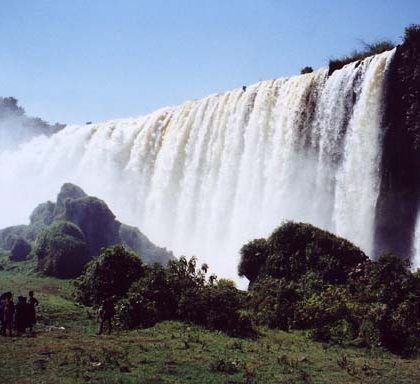
 Discover
Discover
Gonder
Gondar is founded by Emperor Fasilidas in 1636. The city was Ethiopia’s capital until the reign of the would-be reforming Emperor Tewodros II, also know as Thedore. Gonder is famous for its many medieval castles and the design and decoration of its churches. The earliest of the castles was created by Fasilidas himself and is still in such an excellent state of repair that it is possible to climb its stairs all the way to the roof, which commands a breathtaking view over much of the city.
Besides the famous palaces, visitors should inspect the Bathing Place of Emperor Fasilidas, which is used for the annual Timket or epiphany celebrations, and the abbey of the redoubtable 18th- century Empress Mentewab at Qwesquam, in the mountains just outside Gonder.
 Discover
Discover
Harar
Harar is medieval walled city which is considered as eastern historic route and stands amid green mountains on the east wall of the Great Rift Valley. Harar’s heritage is almost entirely Muslim and Oriental. Harar has probably always had a great deal more in common with the Horn’s coastal culture than with the life of the highlands –and it retains to this day a certain redolence of the Orient. The most dominant features, apart from its strong encircling walls, are its rich and exciting market place probably the most colorful in Ethiopia.
With its 90 mosques and shrines, Harar is considered to be the fourth- most sacred centre of the Islamic world; Its Islamic character is best expressed in the Grand Mosque (Al Jami), which dominates the town.
Harar’s Megalo Gudo market is a centre for beautiful baskets of woven grass, decorative wall-mats and bright shawls, as well as all the fruits, vegetables, spices and grains of the province. Harar’s five gates-the only means to enter or leave the city centre-have been strongly guarded over the years. The fully restored Rimbaud house is well worth a visit.
 Discover
Discover
Nature & Wildlife
Ethiopia boasts seven of the Great Rift Valley lakes. Some are alkaline brown, yet surprisingly good for swimming some are tropical in setting; some are bordered or fed by hot mineral springs; some play host to large flocks of flamingos, pelicans, cormorants, herons, storks and ibises; with 831 recorded bird species, Ethiopia is a bird-watcher’s paradise.
Ethiopia’s Lake Tana is the source of the Blue Nile. The lake is dotted with island monasteries, which house many treasures of medieval art Only 30 kilometres from the lake, the river explodes over Tis lsat falls (meaning’ smoke of fire’) – a sight that inspired wonder from the 18th century explorer, James Bruce. Before the Blue Nile joins the White Nile, which flows north from Lake Victoria, it runs for 800 kilometers through one of world’s deepest and most dramatic gorges.
Ethiopia’s mountains rise up to a height of over 4,000 meter, with Mount Batu, the second highest peak in Ethiopia, rising to 4,307 metres. The national parks enable the visitor to enjoy the country’s scenery and its wildlife, conserved in natural habitats, and offer opportunities for travel adventure unparallel in Africa.
 Discover
Discover
Awash national Park
Awash national Park is the oldest and most developed wildlife reserve in Ethiopia. Featuring the 1,800-metre Fantalle Volcano, numerous mineral hot springs and extraordinary volcanic formations, this natural treasure is bordered to the south by the Awash River and lies 225 kilometers east of the capital Addis Ababa.
The wildlife consists mainly of East African Plains animals. Oryx, bateared fox, caracal aardvark, colobus and green monkeys, Anubis and hamadryas baboons, klip-springer, leopard, bushbuck, hippopotamus, Soemmering’s gazelle, cheetah, lion kudu and 450 species of birds of all kinds live with in the park’s 720 square kilometers.
 Discover
Discover
The Bale Mountains
with their vast moorlands-the lower reaches covered with St. John’s wort- and their extensive heathland, virgin woodlands, pristine mountain streams and alpine climate, remain an untouched and beautiful world. Rising to a height or more than 4,000 meters, the range borders Ethiopia’s southern highlands, whose highest peak, Mount Tullu Deemtu, stands at 4,377 metres.
The Establishment of the 2,400-square-kilometre Bale Mountains National Park was crucial to the survival of the mountain nyala, Menelik’s bushbuck and the simien red fox. This fox is one of the most colorful members of the dog family and more abundant here than anywhere else in Ethiopia. All three endemic animals thrive in this environment, the nyala in particular being seen in large numbers. The Bale Mountains offer some fine high-altitude terrain for horse and foot trekking, and the streams of the park- which become important rivers-further downstream-are well-stocked with rainbow and brown trout.
 Discover
Discover
The Baro River area
accessible by land or air through the western Ethiopian town of Gambela, remains a place of adventure and challenge. Traveling across the undulating plains of high Sudanese grass, visitors can enjoy a sense of achievement in simply finding their way around. This is Ethiopia’s true tropical zone and here are found all the elements of the African safari, enhanced by a distinctly Ethiopian flavor Nile perch weighing too kilos can be caught in the waters of Baro, snatched from the jaws of the huge crocodiles that thrive along the riverbank,
The white-eared kob also haunts the Baro along with other riverbank residents that include the Nile lechwe, buffalo, giraffe, tiang, waterbuck roan antelope, zebra, bushbuck, roan antelope. Abyssinian reedbuck, warthog, hartebeest, lion elephant and hippopotamus.
 Discover
Discover
The Simien Mountain
massif is a broad plasteau, cut off to the north and west by an enormous single crag over 60 kilometres long. To the south, the tableland slopes gently down to 2,200 metres, divided by gorges 1,000 metres deep which can take more than two days to cross Insufficient geological time has elapsed to smooth the contours of the crags and buttresses of hardened basalt.
Within this spectacular splendor live the Walia (Abyssinian) ibex, Simien red fox and Gelada baboon-all endemic to Ethiopia- as well as the hamadryas baboon, klipspringer and bushbuck.
Birds such as the lammergeyer, augur buzzard, Verreaux’s eagle, kestrel and falcon soar above this mountain retreat. Twenty kilometers north-east of Gonder,the Simien Mountains National Park covers 179 square kilometers of highland area at an average elevation of 3,300 meters. Ras Dashen at 4,620 metres the highest peak in Ethiopia stands adjacent to the park.
The Simien escarpments which are often compared to the Grand Canyon in the United States of America have been named by UNFSCO as a World Heritage Site.
 Discover
Discover
Omo Valley
Omo Valley is dominated mainly by many ethnic groups who speak omotic language as classified by linguistics. The region and the people of this are one of the least affected by the modern world. The life style of the people has hardly changed for centuries. People still live in simple make shift huts, dress animal skins and drink with calabashes. The area is a veritable paradise for photographers and naturalists.
The people of the Omo Valley and their culture have been source of fascination for travelers. The Hammar who are well known for their sense of elegance are the major ethnic group in the region.
The Surma and Mursi women, who wear lip plates by piercing their lower lip have been compelling tourists to travel to their land to see what seems impossible.
 Discover
Discover
Afar Region
The Afar region is part of the Ethiopian Rift Valley. Since the late 1960s it has attracted the attention of researchers because of its uniqueness as the world’s only active, superior triple junction where the complex tectonics and volcanism of an area between three separating lithosphere plates (African, Eastern African, and Arabian) can be observed on dry land. From archaeological point of view it was from this region that LUCY, the most important hominid skeleton dated at about 3.5 million years discovered.
Any one who wants to visit the homeland of this Great, Great, Great grandmother of the 6 Billion people of the world have to travel to the Afar region. The Denakil Depression, at 120 meters below sea level is one of the lowest points on earth’s surface and it is found in the Afar region.
 Discover
Discover
Addis Ababa
With a population of more than three million people, Addis Ababa is not only the political capital but also the economic and social nerve centre of Ethiopia Founded by Emperor Menlik in 1887 this big, sprawling, hospitable city still bears the stamp of his exuberant personality. More than 21,000 hectares in area, Addis Ababa is situated in the foothills of the 3,000 meters Entoto Mountains and rambles pleasantly across many wooded hillsides and gullies cut through with fast flowing streams.
Addis Ababa is also considered as unofficial capital of Africa as many embassies and international organization head quarter is located in Addis. Ancient buildings, unique churches, many museums, the famous open air market of Mercato are few attractions in Addis.

